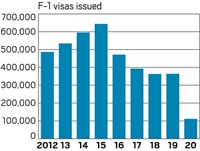Advertisement
Grab your lab coat. Let's get started
Welcome!
Welcome!
Create an account below to get 6 C&EN articles per month, receive newsletters and more - all free.
It seems this is your first time logging in online. Please enter the following information to continue.
As an ACS member you automatically get access to this site. All we need is few more details to create your reading experience.
Not you? Sign in with a different account.
Not you? Sign in with a different account.
ERROR 1
ERROR 1
ERROR 2
ERROR 2
ERROR 2
ERROR 2
ERROR 2
Password and Confirm password must match.
If you have an ACS member number, please enter it here so we can link this account to your membership. (optional)
ERROR 2
ACS values your privacy. By submitting your information, you are gaining access to C&EN and subscribing to our weekly newsletter. We use the information you provide to make your reading experience better, and we will never sell your data to third party members.
Graduate School
Foreign students and postdocs in U.S. worry about the future
While Trump takes aim at immigration, foreign trainees consider taking their talents elsewhere
by Linda Wang
March 7, 2017
| A version of this story appeared in
Volume 95, Issue 11

In late January, when President Donald J. Trump’s initial executive order took effect barring people from seven predominantly Muslim countries from entering the U.S. for 90 days, the scientific community reacted swiftly. Among them, foreign graduate students and postdocs in the U.S. scrambled to figure out how such travel restrictions would affect them.
Foreign talent fills labs
Source: National Science Foundation’s National Center for Science & Engineering Statistics

Source: National Science Foundation’s National Center for Science & Engineering Statistics
“The first 24 hours, nobody did any work,” says Saghi Saghazadeh, an Iranian postdoc in the lab of Ali Khademhosseini at Harvard Medical School. “I was constantly refreshing news websites; that’s all I did.”
A federal judge issued a stay on that executive order, but President Trump on March 6 announced a new executive order that suspends for 90 days immigration from six, instead of seven, predominantly Muslim countries: Iran, Libya, Somalia, Sudan, Syria, and Yemen. Iraq, which was listed in the first immigration executive order, is no longer on the list.
These curbs on immigration are prompting foreign grad students and postdocs in the U.S. to consider alternative plans for their education and career, including moving to another country.
“I’m walking on eggshells, and I don’t know what’s going to happen,” Saghazadeh says. “The worst part is that we cannot plan for the future.”
The National Science Foundation’s National Center for Science & Engineering Statistics conducts a Survey of Graduate Students & Postdoctorates in Science & Engineering. According to that survey, 45% of full-time graduate students in science and engineering in the U.S. were on a temporary visa in 2015.
Khademhosseini, who is researching tissue engineering, says the majority of students and postdocs in his lab are from other countries.
“We are very multicultural in our lab, and it’s representative of most labs in the U.S.,” he says. “I’ve always appreciated this vision of inclusiveness that the U.S. has had where if you work hard, you have the opportunity to do great no matter where you’re from.”
Khademhosseini, who is originally from Iran, says he’s worried about the long-term impact these political actions will have on U.S. competitiveness in science and technology. “There are many places in the world that would love to have smart, educated people who have skills in science and technology,” he says.
Khademhosseini and 45 other journal editors recently published an editorial in ACS Nano encouraging the scientific community to promote a culture of inclusiveness, tolerance, and diversity (2017, DOI: 10.1021/acsnano.7b00953).
Foreign grad students and postdocs whom C&EN spoke with said they are seriously considering leaving the U.S. for countries that have a more welcoming immigration policy. “I’m questioning staying in America, and I have already started looking through documents for Canada,” Saghazadeh says. “I will go to a country where I have to worry less about my life.”
Cathleen Crudden, a chemistry professor at Queen’s University in Ontario and a member of C&EN’s advisory board, says she has been fielding phone calls and e-mails every day from foreign scientists in the U.S. and other countries inquiring about joining her lab. “I’ve had people from the U.S. contact me to say that they want to move in the middle of their Ph.D. program,” she says. “That tells you how people are feeling, that they’re willing to do that.”
But just because a foreign grad student or postdoc moves to Canada doesn’t guarantee an easier life. “The challenge in Canada is that we don’t have the same capacity in terms of the workforce,” Crudden says. “But that can always change. Most of the industry in Canada is made up of small multinational enterprises. But our government is interested in investing in science and technology. With growth and proper investment, we could certainly improve” the opportunities available in the chemical industry, she says.
The political uncertainty is discouraging foreign talent from heading to the U.S., whether for education, for work, or even just a scientific meeting. Grad students and postdocs who are from the affected countries worry that they won’t be able to travel to the U.S. for conferences. Sogol Borjian, an Iranian scientist at Queens University, is program chair for an optical society conference in the U.S. in June, and she is not certain that she will be able to get a visa to attend. The American Chemical Society is hearing similar concerns from those scheduled to attend its national meeting in San Francisco next month.
Meanwhile, Sara Mahshid, an Iranian postdoc at the University of Toronto, says that because of the executive order, she was unable to attend a job interview at the University of California, Davis. She and her sister, Sahar, also a postdoc at the University of Toronto, are now wondering whether they should apply for jobs in the U.S. at all. “Even if I have a visa to enter the U.S., if I’m not eventually able to get a green card or a work permit, there is no point in offering someone like me a job,” Sara Mahshid says.
It’s not just students and postdocs from the affected countries who are feeling unsettled. A graduate student at Oklahoma State University who came to the U.S. from India in 2011 says he worries about potential changes that might happen to the process of obtaining an H-1B temporary work visa. He didn’t want his name included out of concern for his career prospects.
On March 3, the Trump Administration announced suspension of expedited processing of H-1B visas for up to six months. And several bills now in Congress propose additional changes to the H-1B visa process.
For example, Rep. Zoe Lofgren (D-Calif.) has introduced the High-Skilled Integrity & Fairness Act of 2017, a bill designed to curb what some see as H-1B visa outsourcing abuse and instead attract highly skilled and highly paid workers. One portion of the bill deals with employers that are considered H-1B dependent—those that have at least 15% of their employees on H-1B visas.
With Lufgren’s proposal, an H-1B-dependent employer would have to pay a certain percentage of its H-1B visa holders at least $130,000 annually to avoid restrictions regarding recruiting and displacing U.S. workers. That’s a significant increase from the current H-1B-dependent wage exemption level of $60,000. What’s more, the bill proposes a new formula to calculate the H-1B prevailing wage and allocation of H-1B visas.
“The bigger corporations would be in a position to be able to absorb those much higher wages, and they’re hiring more computer programmers, computer engineers, and software engineers,” says Brendan Delaney, an immigration lawyer with Leavy, Frank & Delaney in Bethesda, Md. “If you’re a scientist on more of the research side of things, and a small or midsized biotech company wants to hire you, where are they going to be in all of this?”
The number of H-1B visas awarded to researchers in the chemical sciences is already extremely low. In 2015, according to data from the U.S. Citizenship & Immigration Services, initial H-1B petitions approved in occupations in mathematics and physical and life sciences accounted for approximately 4% of the total approved H-1B petitions. In comparison, 62% of the approved H-1B petitions went to computer-related occupations.
“If I get a job in the U.S., I would stay, but if I don’t get a job, what am I going to do? I have to plan accordingly,” says the Oklahoma State grad student. “I don’t feel secure, and I don’t have a clear vision of what’s going to happen. I have to look at other options.” He says he’s looking into opportunities in Australia, New Zealand, Japan, and countries in Europe, as well as prospects back home in India.
Delaney points out that applying for an EB-1 “extraordinary ability” or an EB-2 “national interest waiver” green card is still an option for foreign scientists, although the bar for getting one of these green cards is high. “If you’re good enough and you’re accomplished enough, you can make a solid case,” Delaney says. “At least there are still avenues open without having to be sponsored by companies.” He encourages foreign scientists to educate themselves about the process so they know their options moving forward. At the ACS Career Fair at the society’s national meeting in San Francisco in April, an immigration law firm will be available to answer questions about visas and other immigration issues. ACS will also be offering a workshop on navigating the U.S. visa process.
Foreign grad students and postdocs say they feel more isolated from their colleagues. “I’m the only person from one of the seven countries in my group,” says Hooman Yaghoobnejad Asl, an Iranian postdoc at the University of Pennsylvania. “It somehow affects the way other people see you. Everyone is asking, ‘So, what’s going to happen to you next?’ I feel like I’ve been separated from the group, and everyone is concerned about me.”
Despite the political uncertainties, one thing is certain: “Scientists are learning to speak up,” Khademhosseini says. “Many of the people I know who are scientists have never really been involved in activism and politics, but these kinds of things have made a lot more people aware, and they’ve started to think about how they can let their voices be heard,” he says.
Saghazadeh agrees. “As international scientists we have always been closed in our labs, and we have not been communicating with people. That’s why they see us as strangers,” she says. “We should find a way to talk to people, and I hope we can get to a point where we can have a dialogue.”




Join the conversation
Contact the reporter
Submit a Letter to the Editor for publication
Engage with us on Twitter